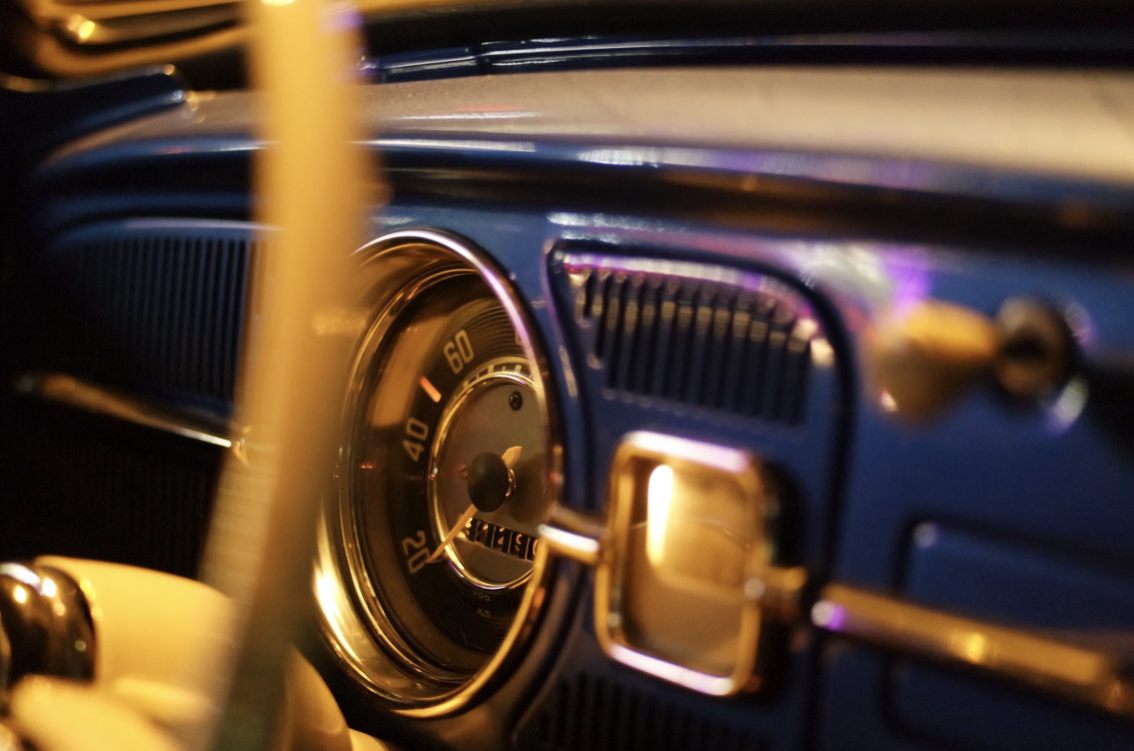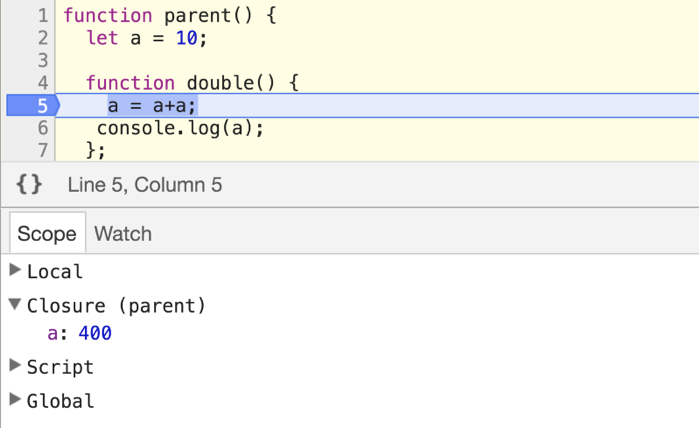JavaScript Closures

Every function in JavaScript has a closure. And this is one of the coolest features of the JavaScript language. Because without closures, it would be hard to implement common structures like callbacks or event handlers.
You create a closure whenever you define a function. Then when you execute functions, their closures enable them to access data in their scopes.
It’s kind of like when a car is manufactured (defined) it comes with a few functions like start, accelerate, decelerate. These car functions get executed by the driver every time they operate the car. Closures for these functions come defined with the car itself and they close over variables they need to operate.
Let’s narrow this analogy to the accelerate function. The function definition happens when the car is manufactured:
function accelerate(force) {
// Is the car started?
// Do we have fuel?
// Are we in traction control mode?
// Many other checks...
// If all good, burn more fuel depending on
// the force variable (how hard we're pressing the gas pedal)
}
Every time the driver presses the gas pedal, this functions gets executed. Note how this function needs access to a lot of variable to operate, including its own force variable. But more importantly, it needs variables outside of its scope that are controlled by other car functions. This is where the closure of the accelerate function (which we get with the car itself) comes in handy.
Here’s what the accelerate function’s closure promised to the accelerate function itself:
Okaccelerate, when you get executed, you can access yourforcevariable, you can access theisCarStartedvariable, you can also access thefuelLevelvariable, and theisTractionControlOnvariable. You can also control thecurrentFuelSupplyvariable that we’re sending to the engine.
Note that the closure did not give the accelerate function fixed values for these variables, but rather permission to access those values at the time the accelerate function is executed.
Closures are closely related to function scopes, so understanding how these scopes work will help you understanding closures. In short, the most important thing to understand about scopes is that when you execute a function, a private function scope is created and used for the process of executing that function.
Then these function scopes get nested when you execute functions from within functions (which you’ll do all the time).
A closure is created when you define a function — not when you execute it. Then, every time you execute that function, its already-defined closure gives it access to all the function scopes available around it.
In a way, you can think of scopes as temporary (the global scope is the only exception to this), while you can think of closures themselves as permanent.

To truly understand closures and the role they play in JavaScript, you first need to understand a few other simple concepts about JavaScript functions and their scopes.
Before we get started, note that I’ve also created an interactive lab for this, which you can work through here.
1. Functions are assigned by value reference
When you put a function in a variable like this:
function sayHello() {
console.log("hello");
};
var func = sayHello;
You are assigning the variable func a reference to the function sayHello, not a copy. Here, func is simply an alias to sayHello. Anything you do on the alias you will actually be doing on the original function. For example:
func.answer = 42;
console.log(sayHello.answer); // prints 42The property answer was set directly on func and read using sayHello, which works.
You can also execute sayHello by executing the func alias:
func() // prints "hello"
2. Scopes have a lifetime
When you call a function, you create a scope during the execution of that function. Then that scope goes away.
When you call the function a second time, you create a new different scope during the second execution. Then this second scope goes away as well.
function printA() {
console.log(answer);
var answer = 1;
};
printA(); // this creates a scope which gets discarded right after
printA(); // this creates a new different scope which also gets discarded right after;
These two scopes that were created in the example above are different. The variable answer here is not shared between them at all.
Every function scope has a lifetime. They get created and they get discarded right away. The only exception to this fact is the global scope, which does not go away as long as the application is running.
3. Closures span multiple scopes
When you define a function, a closure gets created
Unlike scopes, closures are created when you define a function, not when you execute it. Closures also don’t go away after you execute that function.
You can access the data in a closure long after a function is defined and after it gets executed as well.
A closures encompasses everything the defined function can access. This means the defined function’s scope, and all the nested scopes between the global scope and the defined function scope plus the global scope itself.
var G = 'G';
// Define a function and create a closure
function functionA() {
var A = 'A'
// Define a function and create a closure
function functionB() {
var B = 'B'
console.log(A, B, G);
}
functionB(); // prints A, B, G
// functionB closure does not get discarded
A = 42;
functionB(); // prints 42, B, G
}
functionA();
When we define functionB here, its created closure will allow us to access the scope of functionB plus the scope of functionA plus the global scope.
Every time we execute functionB, we can access variables B, A, and G through its previously created closure. However, that closure does not give us a copy of these variables but rather a reference to them. So if, for example, the value of the variable A gets changed at some point after the closure of functionB is created, when we execute functionB after that, we’ll see the new value, not the old one. The second call to functionB prints 42, B, G because the value of variable A was changed to 42 and the closure gave us a reference to A, not a copy.
Don’t confuse closures with scopes
It’s common for closures to be confused with scopes, so let’s make sure not to do that.
// scope: global
var a = 1;
void function one() {
// scope: one
// closure: [one, global]
var b = 2;
void function two() {
// scope: two
// closure: [two, one, global]
var c = 3;
void function three() {
// scope: three
// closure: [three, two, one, global]
var d = 4;
console.log(a + b + c + d); // prints 10
}();
}();
}();
In the simple example above, we have three functions and they all get defined and immediately invoked, so they all create scopes and closures.
The scope of function one() is its body. Its closure gives us access to both its scope and the global scope.
The scope of function two() is its body. Its closure gives us access to its scope plus the scope of function `one()`plus the global scope
And similarly, the closure of function three() gives us access to all scopes in the example. This is why we were able to access all variables in function three().
But the relation between scopes and closures is not always simple like this. Things become different when the defining and invoking of functions happen in different scopes. Let me explain that with an example:
var v = 1;
var f1 = function () {
console.log(v);
}
var f2 = function() {
var v = 2;
f1(); // Will this print 1 or 2?
};
f2();
What do you think the above example will print? The code is simple, f1() prints the value of v, which is 1 on the global scope, but we execute f1() inside of f2(), which has a different v that’s equal to 2. Then we execute f2().
Will this code print 1 or 2?
If you’re tempted to say 2, you’ll be surprised. This code will actually print 1. The reason is, scopes and closures are different. The console.log line will use the closure of f1(), which is created when we define f1(), which means the closure of f1() gives us access to only the scope of f1() plus the global scope. The scope where we execute f1() does not affect that closure. In fact, the closure of f1() will not give us access to the scope of f2() at all. If you remove the global v variable and execute this code, you’ll get a reference error:
var f1 = function () {
console.log(v);
}
var f2 = function() {
var v = 2;
f1(); // ReferenceError: v is not defined
};
f2();
This is very important to understand and remember.
4. Closures have read and write access
Since closures give us references to variables in scopes, the access that they give us means both read and write, not just read.
Take a look at this example:
function outer() {
let a = 42;
function inner() {
a = 43;
}
inner();
console.log(a);
}
outer();
The inner() function here, when defined, creates a closure that gives us access to the variable a. We can read and modify that variable, and if we do modify it, we will be modifying the actual a variable in the outer() scope.
This code will print 43 because we used the inner() function closure to modify the outer() function variable.
This is actually why we can change global variables everywhere. All closures give us both read and write access to all global variables.
5. Closures can share scopes
Since closures give us access to nested scopes at the time we define functions, when we define multiple functions in the same scope, that scope is shared among all created closures, and of course, because of this, the global scope is always shared among all closures.
function parent() {
let a = 10;
function double() {
a = a+a;
console.log(a);
};
function square() {
a = a*a;
console.log(a);
}
return { double, square }
}
let { double, square } = parent();
double(); // prints 20
square(); // prints 400
double(); // prints 800
In the example above, we have a parent() function with variable a set to 10. We define two functions in this parent() function’s scope, double() and square(). The closures created for double() and square() both share the scope of the parent() function. Since both double() and square() change the value of a, when we execute the last 3 lines, we double a (making a = 20), then square that doubled value (making a = 400), then double that squared value (making a = 800).
I hope you got that right and I hope these simple concepts will help you to truly understand the significant role function closures play in JavaScript.